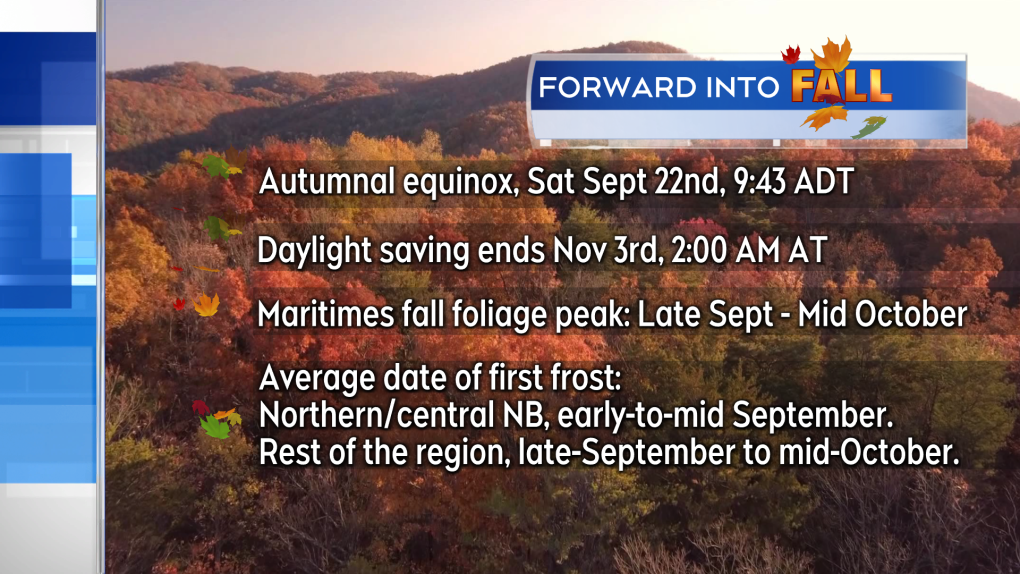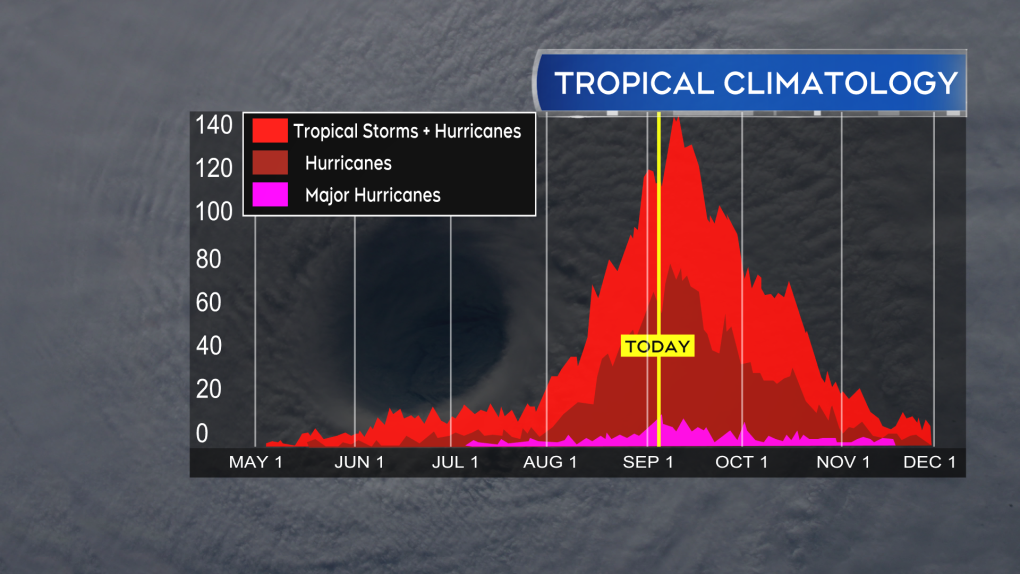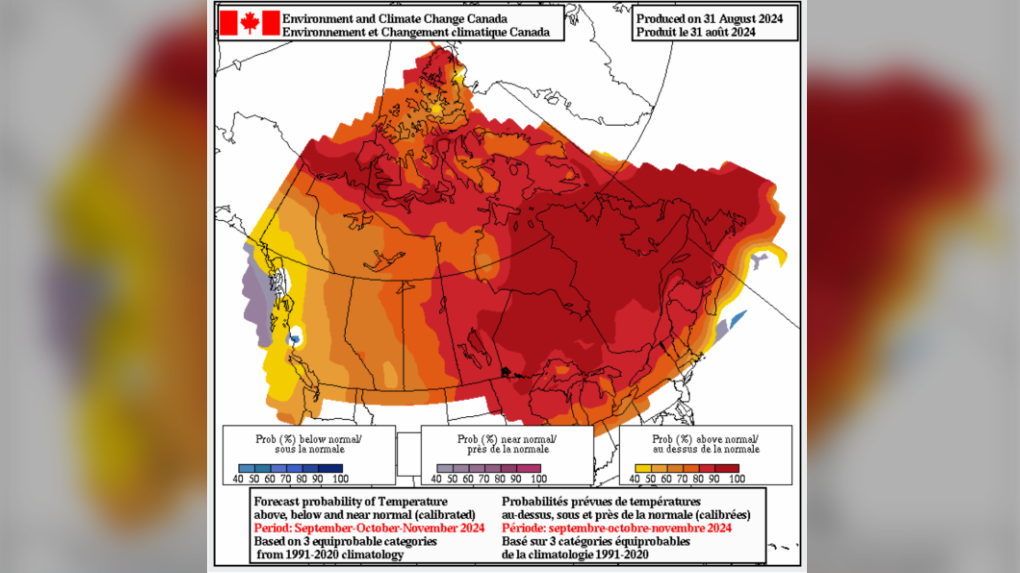Five things to know heading into the fall season for the Maritimes
 Signs of an early start to the change for some of the foliage in Inverness, Cape Breton. (Courtesy: Francis MacDonald)
Signs of an early start to the change for some of the foliage in Inverness, Cape Breton. (Courtesy: Francis MacDonald)
The autumnal equinox will be at 9:43 a.m. ADT on Saturday, Sept. 22. Most take that as the official start of fall. The meteorological start of fall, for statistical purposes, is taken as Sept. 1.
Daylight saving time ends on Sunday, Nov. 3 at 2 a.m. local time. It’s a great time to check or change batteries in smoke and carbon monoxide detectors if needed.
 The start of fall, end of daylight saving time, and end of the hurricane season all ahead the next two months. (Source: CTV News Atlantic)
The start of fall, end of daylight saving time, and end of the hurricane season all ahead the next two months. (Source: CTV News Atlantic)
Fall foliage
You can’t talk about the fall season without mentioning the amazing display of colour in the Maritimes. The typical peak for the fall colours in the region is late-September through mid-October.
There can be some variation dependent on overall weather conditions. I have had some reports from some areas of signs of an earlier change this year, possibly due in part to some extended stretches of dry weather in the month of August. Dry weather can stress trees, leading to an earlier change.
First frosts
Average dates of first frost for northern and central areas of New Brunswick are typically early-to-mid September. The same is true for interior areas of eastern mainland Nova Scotia and the Cape Breton Highlands. For the rest of the region – including southern New Brunswick, Prince Edward Island, and Nova Scotia – first frost happens late-September to mid-October.
Environment Canada only issues Frost Advisories up until the end of the growing season.
 Average dates of first frost in the Maritimes. (Source: CTV News Atlantic)
Average dates of first frost in the Maritimes. (Source: CTV News Atlantic)
Hurricane season peaks and ends
The Atlantic hurricane season peaks this month. The season ends on Nov. 30.
Despite predictions of a very active hurricane season, it has so far turned out to be lower than average. A number of reasons are being explored for this, including the presence of more Saharan dust over the Atlantic, a windier environment over the Atlantic than expected, and a more northerly position of the African monsoon.
 The peak of the Atlantic hurricane season is typically in the month of September. The season ends on Nov. 30. (Source: CTV News Atlantic)
The peak of the Atlantic hurricane season is typically in the month of September. The season ends on Nov. 30. (Source: CTV News Atlantic)
Season predictions for temperature and precipitation
There is a strong consensus for above normal temperatures for the period of September through November in the Maritimes. According to the Canada Changing Climate Report published in 2019, summer and autumn have seen the greatest temperature increase in Atlantic Canada.
Predictions for precipitation for September through November vary from near-to-below normal. There is typically less confidence in the prediction for seasonal precipitation compared to seasonal temperature.
For the provincial capitals, on average, the first five centimetres snowfall occurs in the month of November.
 Seasonal predictions for the Maritimes by Environment Canada are for above normal temperatures and below normal precipitation. (Source: CTV News Atlantic)
Seasonal predictions for the Maritimes by Environment Canada are for above normal temperatures and below normal precipitation. (Source: CTV News Atlantic)
CTVNews.ca Top Stories

BREAKING Poilievre to submit letter to Governor General asking to recall House for confidence vote
Conservative Party Leader Pierre Poilievre announced that he will submit a letter to the Governor General asking to recall the House for a confidence vote.
'I understand there's going to be a short runway,' new minister says after Trudeau shuffles cabinet
Prime Minister Justin Trudeau added eight Liberal MPs to his front bench and reassigned four ministers in a cabinet shuffle in Ottawa on Friday, but as soon as they were sworn-in, they faced questions about the political future of their government, and their leader.
Judge sentences Quebecer convicted of triple murder who shows 'no remorse'
A Quebecer convicted in a triple murder on Montreal's South Shore has been sentenced to life in prison without chance of parole for 20 years in the second-degree death of Synthia Bussieres.
BREAKING Fake nurse Brigitte Cleroux sentenced to 7 years in prison
A woman who illegally treated nearly 1,000 patients in British Columbia while impersonating a nurse has been sentenced to seven years in prison.
Poilievre to Trump: 'Canada will never be the 51st state'
Conservative leader Pierre Poilievre is responding to U.S. president-elect Donald Trump’s ongoing suggestions that Canada become the 51st state, saying it will 'never happen.'
Toronto officials warn of possible measles exposure at Pearson airport
Toronto Public Health (TPH) is advising of another possible measles exposure at Canada’s largest airport.
Party City closing in U.S., Canadian stores remain 'open for business'
The impending closure of all Party City locations in the United States will not extend into Canada.
BREAKING At least one dead and 50 injured after a car drove into a German Christmas market, official says
A car plowed into a busy outdoor Christmas market in the eastern German city of Magdeburg on Friday, leaving at least one person dead and injuring at least 50 others in what authorities suspect was an attack.
Guelph man facing assault charge after police say he spat in roommate's face during disagreement over cat
A fight between roommates has led to an assault charge for a Guelph man.

































